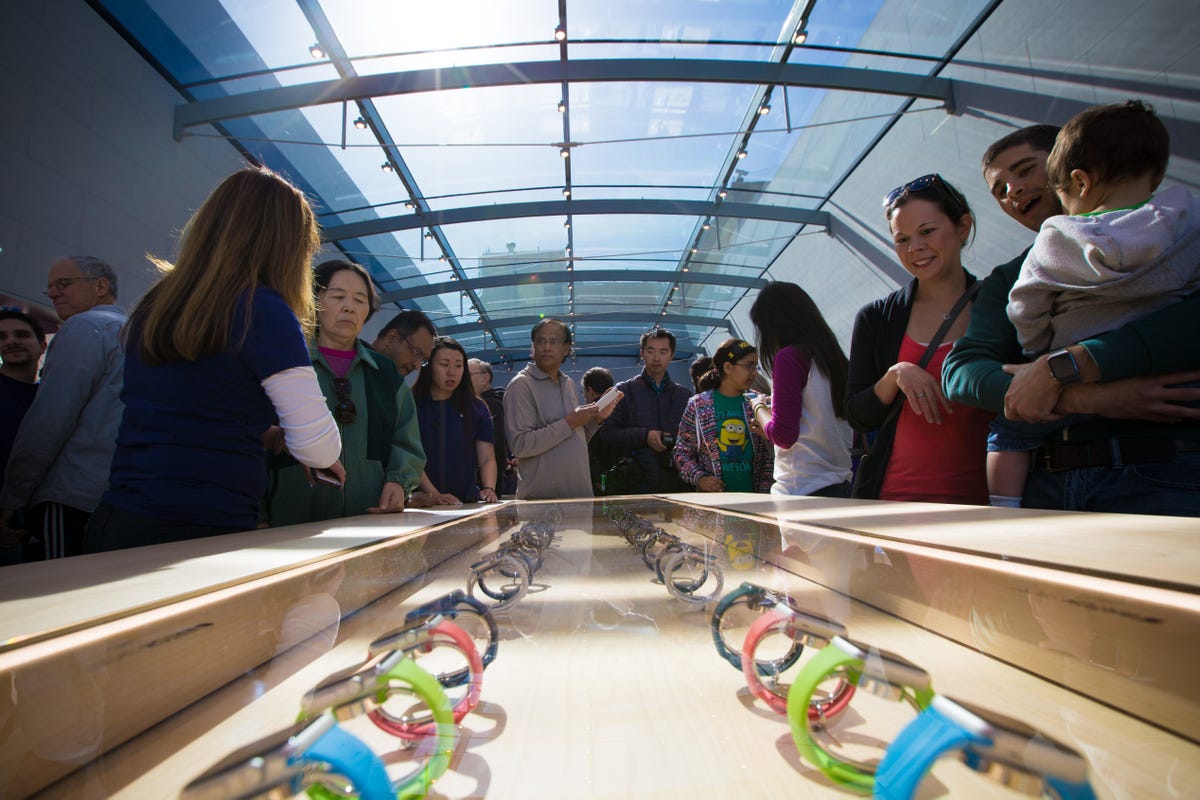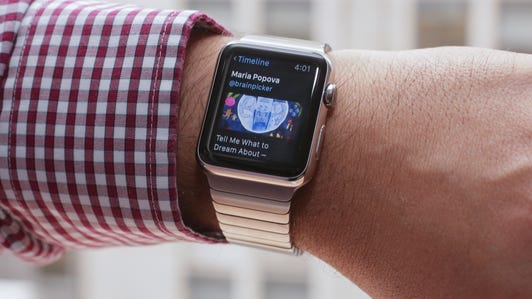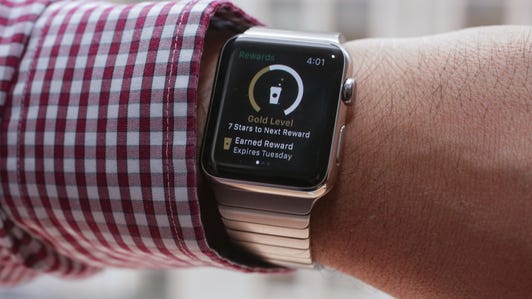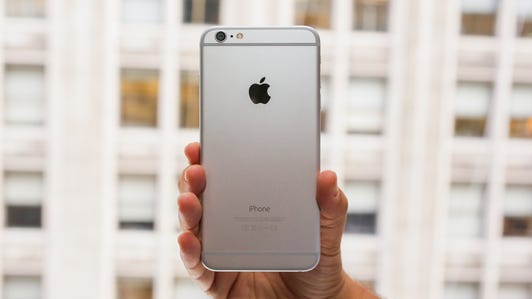
James Martin/CNET
The Apple Watch, which was delivered to customers around the world starting last week, may be what everyone’s talking about right now.
But when it comes to Apple’s financials, it’s still all about the iPhone.
The Cupertino, Calif., company on Monday will report its second-quarter earnings, giving an update on how many phones, tablets and computers it sold from January to the end of March. It’s also expected to increase the amount of money it returns to shareholders in dividends.
But while investors and analysts will undoubtedly ask plenty of questions about Apple’s first smartwatch on the conference call — with everyone wanting to know how many devices have been purchased and when supply will be able to keep up with demand — Apple has already said it won’t provide details on watch sales.
When CEO Tim Cook introduced the Apple Watch in September, he called the smartwatch a breakthrough product and Apple’s “most personal device yet.” He also described it as a comprehensive health and fitness device, an “incredibly accurate” timepiece and a way to communicate immediately and intimately with others.
See also
- CNET’s take on Apple Watch
- Seven things we learned from Apple’s Q1 earnings call
- Waiting for the Apple Watch: A less than luxury experience
As of Friday’s launch day, more than 3,000 apps were available for the device, which only works with an iPhone 5 or newer. Wait times for the Apple Watch, which costs from $349 for the sport version to $17,000 for the gold edition, now stretch into July. Apple hasn’t revealed the watch’s sales figures and it doesn’t plan to break out the results in its quarterly reports. Still, some analysts believe the company has sold 2 million Apple Watch units in just the two weeks of preorders.
While the Apple Watch has captured the world’s attention, it won’t factor into fiscal second-quarter results. The period ended a couple weeks before preorders started for the watch on April 10 and nearly a month before customers could actually get their hands on the device. Last quarter, the iPhone accounted for almost 70 percent of sales.
“From Wall Street’s standpoint, they’re looking at two things — the sales of iPhone in the last quarter and some feedback…on what the preorders were for the watch,” said Tim Bajarin, president of tech research firm Creative Strategies.
The company didn’t respond to a request for comment ahead of the report.
All about iPhone
Apple’s December quarter — which includes the holidays and the first full period of new iPhone sales — tends to be the biggest three months of the year for the company. That certainly was true this time around. For that quarter, Apple reported the highest revenue in its 38-year history and the highest profit of any company — ever — selling a record 74.5 million iPhones. Apple has been benefiting from blockbuster demand for its 4.7-inch iPhone 6 and 5.5-inch 6 Plus devices since their release in September.
But Apple also has been more dependent on the iPhone than usual — largely because demand has soared for its smartphones but fallen for its tablets. About 69 percent of Apple’s $74.6 billion in sales last quarter came from the iPhone. That smartphone typically has accounted for half of Apple’s sales in previous quarters. Being reliant on one device poses a big risk for any company, including Apple, and that has led it to expand into new markets with products such as wearables with the Apple Watch and mobile payments with Apple Pay.
In the past, huge iPhone demand in the first quarter made second-quarter results pale in comparison. Most analysts expect the same pattern this year. Apple is believed to have sold 56.8 million iPhones in its second quarter, according to an analyst poll by Fortune. That’s about 30 percent more than in the year-earlier quarter.
14 third-party Apple Watch apps we like (pictures)






Analysts also forecast a 25 percent drop in revenue from the first quarter to $56.06 billion — lower than Apple’s average 19 percent decline in the second quarter for the past three years, according to Bernstein analyst Toni Sacconaghi.
That drop may be steeper this year in part because some European countries got the iPhone sooner than in the past, he noted. Still, iPhone supplies fell short until late in the first quarter, which could help second-quarter results.
“On net, we believe that consensus and our revenue forecast point to the potential for upside,” Sacconaghi said.
Apple is expected to report earnings of $2.16 a share on $56.06 billion in revenue, according to analysts polled by Thomson Reuters. In January, Apple, which tends to low-ball its forecast, projected sales of $52 billion to $55 million, which was largely in line with Wall Street’s estimates at the time.
Wall Street expects Apple to forecast revenue of $47.06 billion for the fiscal third quarter, which ends in June.
The China factor
The wildcard in the quarter could be China. While Western markets such as the US tend to buy more devices at the end of the calendar year, China tends to spend more around its New Year in February.
China became the world’s largest smartphone market in 2011 and now is home to almost 520 million smartphone users. Apple has been working to gain market share in the country by reaching deals with major carriers in the region. An agreement with the world’s largest carrier, China Mobile, gives Apple access to more than 800 million subscribers.


Now playing:
Watch this:
How to navigate the Apple Watch in 10 helpful moves
3:00
China came close to passing the US as Apple’s biggest iPhone market in the fiscal first quarter. The company generated $16.1 billion in revenue in Greater China in the period, up 70 percent from the same quarter a year ago. In mainland China, sales more than doubled from the previous year. Greater China — which includes mainland China, Hong Kong and Taiwan — represented 22 percent of Apple’s total sales during the quarter ended December 27.
Analysts at Trefis noted that Apple’s fiscal second quarter “will be all about China.”
“We believe that iPhone sales in Greater China will be the biggest driver of quarterly earnings given the Chinese New Year shopping season that occurred in February, China Mobile’s rapid 4G user additions and an improved supply-demand balance for the iPhone 6 and 6 Plus, both of which remained undersupplied over the previous quarter,” they said last week.
iPad’s struggles
The iPad has been the yin to the iPhone’s yang. The tablet, which hit its five-year anniversary earlier this month, posted its fourth consecutive decline in the first quarter as consumers opted for large phones over Apple’s tablet computers. Unit sales for the iPad dropped 18 percent to 21.4 million in the period ended December 27, slightly below analysts’ predictions of 21.5 million.
Apple introduced its newest tablets — the iPad Air 2 and the iPad Mini 3 — in October, but analysts said their incremental changes, including faster processors, weren’t enough to attract buyers. Instead, many customers either opted for older models or bought an iPhone 6, which has a larger screen than the 4-inch display of the iPhone 5.
Investors and analysts have questioned for months whether the iPad’s declining shipments are a temporary hiccup or a troubling trend. Apple has long claimed iPad weakness is a “speed bump.”
The iPhone 6 Plus is a gorgeous, massive smartphone (pictures)






“I think we’ll see a similar trend to what we were seeing in the last few quarters,” said Jan Dawson, chief analyst at Jackdaw Research. “The trend will carry on for another quarter or two, but it’s possible things will start picking up later this year.”
Sales of the iPad are expected to remain weak in the second quarter, down about 14 percent from the previous year to 14.1 million, according to an analyst poll by Fortune.
At the same time, Mac sales have been strong. Apple sold 5.52 million Macs, up from 4.84 million a year ago and higher than the 5.51 million projected by analysts. Macs accounted for 9.3 percent of sales, and revenue from the computers reached a record high of $6.94 billion.
Apple earlier this month released a redesigned MacBook that’s lighter and thinner than any of its earlier computers. The device is expected to contribute to financial results in the third quarter.
Tune back to CNET after 1 p.m. PT Monday for full coverage of Apple’s earnings.



